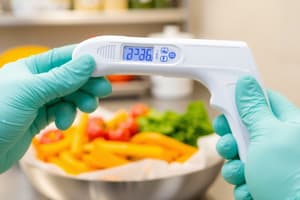Podcast
Questions and Answers
What is cross contamination?
What is cross contamination?
When bacteria from one food item is unintentionally transferred to another food item with harmful effect.
What are the effects of cross contamination?
What are the effects of cross contamination?
Leads to salmonella, and staphylococcus.
Where can E.coli be found?
Where can E.coli be found?
Under-cooked meat, water, and raw milk.
Salmonella is most often found in?
Salmonella is most often found in?
Is contact between raw and cooked food an indirect or direct example of cross contamination?
Is contact between raw and cooked food an indirect or direct example of cross contamination?
What should you do if you are going to cough or sneeze?
What should you do if you are going to cough or sneeze?
Using the same work surfaces, utensils, and equipment while cooking is okay?
Using the same work surfaces, utensils, and equipment while cooking is okay?
What kind of cloth should you use to clean your work surface with?
What kind of cloth should you use to clean your work surface with?
Is handling food with contaminated hands safe?
Is handling food with contaminated hands safe?
What is the danger of cross contamination?
What is the danger of cross contamination?
Name 3 ways how cross contamination occurs?
Name 3 ways how cross contamination occurs?
What are 3 ways to help prevent cross contamination?
What are 3 ways to help prevent cross contamination?
Flashcards are hidden until you start studying
Study Notes
Cross Contamination Overview
- Cross contamination occurs when bacteria from one food item unintentionally transfer to another, potentially causing foodborne illness.
- It is linked to harmful bacteria such as salmonella and staphylococcus.
Common Bacterial Contaminants
- E. coli is often found in undercooked meat, contaminated water, and raw milk.
- Salmonella is primarily present in eggs, dairy, poultry, and beef products.
Direct and Indirect Contamination
- Direct cross contamination occurs through contact between raw and cooked foods.
- Indirect contamination can arise from contact with contaminated surfaces or utensils.
Hygiene Practices
- Cover your mouth while coughing or sneezing to prevent spreading bacteria, and always rewash hands afterward.
- Always wash hands thoroughly before handling any food to eliminate contaminants.
Kitchen Safety
- Avoid using the same work surfaces, utensils, and equipment without proper cleaning, as it can lead to the spread of harmful bacteria.
- Always utilize a clean cloth for cleaning work surfaces to prevent introducing contaminants.
Risks and Prevention
- Cross contamination poses serious health risks, potentially leading to illness and the spread of dangerous bacteria.
- Preventative measures include maintaining clean surfaces, separating different food types, and practicing good hand hygiene.
Studying That Suits You
Use AI to generate personalized quizzes and flashcards to suit your learning preferences.



